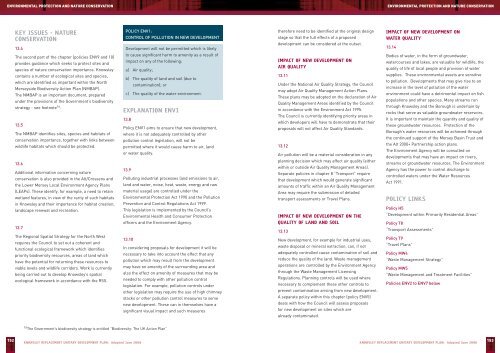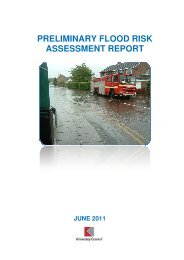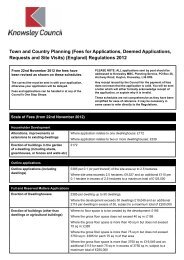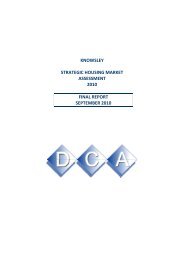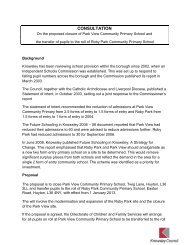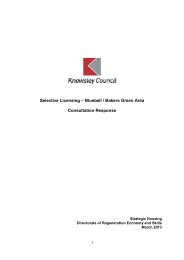Knowsley Replacement Unitary Development Plan - Knowsley Council
Knowsley Replacement Unitary Development Plan - Knowsley Council
Knowsley Replacement Unitary Development Plan - Knowsley Council
Create successful ePaper yourself
Turn your PDF publications into a flip-book with our unique Google optimized e-Paper software.
ENVIRONMENTAL PROTECTION AND NATURE CONSERVATION<br />
ENVIRONMENTAL PROTECTION AND NATURE CONSERVATION<br />
KEY ISSUES - NATURE<br />
CONSERVATION<br />
13.4<br />
The second part of the chapter (policies ENV9 and 10)<br />
provides guidance which seeks to protect sites and<br />
species of nature conservation importance. <strong>Knowsley</strong><br />
contains a number of ecological sites and species,<br />
which are identified as important within the North<br />
Merseyside Biodiversity Action <strong>Plan</strong> (NMBAP).<br />
The NMBAP is an important document, prepared<br />
under the provisions of the Government’s biodiversity<br />
strategy - see footnote 16 .<br />
13.5<br />
The NMBAP identifies sites, species and habitats of<br />
conservation importance, together with links between<br />
wildlife habitats which should be protected.<br />
13.6<br />
Additional information concerning nature<br />
conservation is also provided in the Alt/Crossens and<br />
the Lower Mersey Local Environment Agency <strong>Plan</strong>s<br />
(LEAPs). These identify, for example, a need to retain<br />
wetland features, in view of the rarity of such habitats<br />
in <strong>Knowsley</strong> and their importance for habitat creation,<br />
landscape renewal and recreation.<br />
13.7<br />
The Regional Spatial Strategy for the North West<br />
requires the <strong>Council</strong> to set out a coherent and<br />
functional ecological framework which identifies<br />
priority biodiversity resources, areas of land which<br />
have the potential for returning these resources to<br />
viable levels and wildlife corridors. Work is currently<br />
being carried out to develop <strong>Knowsley</strong>'s spatial<br />
ecological framework in accordance with the RSS.<br />
POLICY ENV1:<br />
CONTROL OF POLLUTION IN NEW DEVELOPMENT<br />
<strong>Development</strong> will not be permitted which is likely<br />
to cause significant harm to amenity as a result of<br />
impact on any of the following:<br />
a) Air quality;<br />
b) The quality of land and soil (due to<br />
contamination); or<br />
c) The quality of the water environment.<br />
EXPLANATION ENV1<br />
13.8<br />
Policy ENV1 aims to ensure that new development,<br />
where it is not adequately controlled by other<br />
pollution control legislation, will not be<br />
permitted where it would cause harm to air, land<br />
or water quality.<br />
13.9<br />
Polluting industrial processes (and emissions to air,<br />
land and water, noise, heat, waste, energy and raw<br />
material usage) are controlled under the<br />
Environmental Protection Act 1990 and the Pollution<br />
Prevention and Control Regulations Act 1999.<br />
This legislation is implemented by the <strong>Council</strong>’s<br />
Environmental Health and Consumer Protection<br />
officers and the Environment Agency.<br />
13.10<br />
In considering proposals for development it will be<br />
necessary to take into account the effect that any<br />
pollution which may result from the development<br />
may have on amenity of the surrounding area and<br />
also the effect on amenity of measures that may be<br />
needed to comply with other pollution control<br />
legislation. For example, pollution controls under<br />
other legislation may require the use of high chimney<br />
stacks or other pollution control measures to serve<br />
new development. These can in themselves have a<br />
significant visual impact and such measures<br />
therefore need to be identified at the original design<br />
stage so that the full effects of a proposed<br />
development can be considered at the outset.<br />
IMPACT OF NEW DEVELOPMENT ON<br />
AIR QUALITY<br />
13.11<br />
Under the National Air Quality Strategy, the <strong>Council</strong><br />
may adopt Air Quality Management Action <strong>Plan</strong>s.<br />
These plans may be adopted on the declaration of Air<br />
Quality Management Areas identified by the <strong>Council</strong><br />
in accordance with the Environment Act 1995.<br />
The <strong>Council</strong> is currently identifying priority areas in<br />
which developers will have to demonstrate that their<br />
proposals will not affect Air Quality Standards.<br />
13.12<br />
Air pollution will be a material consideration in any<br />
planning decision which may affect air quality (either<br />
within or outside Air Quality Management Areas).<br />
Separate policies in chapter 8 “Transport” require<br />
that development which would generate significant<br />
amounts of traffic within an Air Quality Management<br />
Area may require the submission of detailed<br />
transport assessments or Travel <strong>Plan</strong>s.<br />
IMPACT OF NEW DEVELOPMENT ON THE<br />
QUALITY OF LAND AND SOIL<br />
13.13<br />
New development, for example for industrial uses,<br />
waste disposal or mineral extraction, can, if not<br />
adequately controlled cause contamination of soil and<br />
reduce the quality of the land. Waste management<br />
operations are controlled by the Environment Agency<br />
through the Waste Management Licensing<br />
Regulations. <strong>Plan</strong>ning controls will be used where<br />
necessary to complement these other controls to<br />
prevent contamination arising from new development.<br />
A separate policy within this chapter (policy ENV5)<br />
deals with how the <strong>Council</strong> will assess proposals<br />
for new development on sites which are<br />
already contaminated.<br />
IMPACT OF NEW DEVELOPMENT ON<br />
WATER QUALITY<br />
13.14<br />
Bodies of water, in the form of groundwater,<br />
watercourses and lakes, are valuable for wildlife, the<br />
quality of life of local people and provision of water<br />
supplies. These environmental assets are sensitive<br />
to pollution. <strong>Development</strong>s that may give rise to an<br />
increase in the level of pollution of the water<br />
environment could have a detrimental impact on fish<br />
populations and other species. Many streams run<br />
through <strong>Knowsley</strong> and the Borough is underlain by<br />
rocks that serve as valuable groundwater reservoirs.<br />
It is important to maintain the quantity and quality of<br />
these groundwater resources. Protection of the<br />
Borough’s water resources will be achieved through<br />
the continued support of the Mersey Basin Trust and<br />
the Alt 2000+ Partnership action plans.<br />
The Environment Agency will be consulted on<br />
developments that may have an impact on rivers,<br />
streams or groundwater resources. The Environment<br />
Agency has the power to control discharge to<br />
controlled waters under the Water Resources<br />
Act 1991.<br />
POLICY LINKS<br />
Policy H5<br />
“<strong>Development</strong> within Primarily Residential Areas”<br />
Policy T8<br />
“Transport Assessments”<br />
Policy T9<br />
“Travel <strong>Plan</strong>s”<br />
Policy MW4<br />
“Waste Management Strategy”<br />
Policy MW5<br />
“Waste Management and Treatment Facilities”<br />
Policies ENV2 to ENV7 below<br />
16 The Government’s biodiversity strategy is entitled “Biodiversity: The UK Action <strong>Plan</strong>”<br />
152<br />
KNOWSLEY REPLACEMENT UNITARY DEVELOPMENT PLAN: Adopted June 2006<br />
KNOWSLEY REPLACEMENT UNITARY DEVELOPMENT PLAN: Adopted June 2006<br />
153


